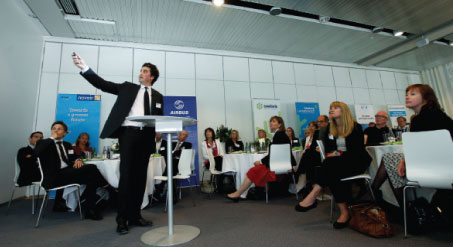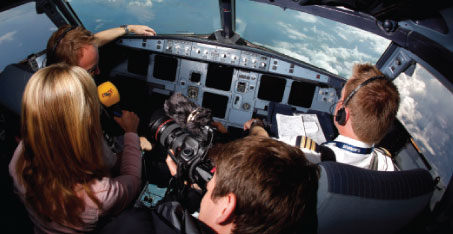
Alain Siebert, Chief Economics and Environment, SESAR: “The idea is to develop a number of arrival and departure procedures to optimise traffic flows at Göteborg Landvetter.”
VINGA is a true collaborative project. It is being coordinated by LFV at Göteborg Landvetter, in cooperation with the airline Novair and Quovadis – a company owned by Airbus and which develops navigation technology. Sweden is a leader in terms of environmental initiatives and Göteborg Landvetter is among the Swedavia airports accredited at the ‘Neutrality’ level of ACI EUROPE’s Airport Carbon Accreditation programme. The VINGA project involves studying all phases of flight to determine how environmental impact can be reduced by various industry stakeholders developing solutions in partnership.
“In this project we use and evaluate various ways to start and land the aircraft, allowing them to operate with as little impact on the environment as possible,” said Niclas Wiklander, VINGA Project Manager. “So far, VINGA has matched our expectations. We have demonstrated that by using best practice, together with state-of-the-art technology, we can reduce emissions and aircraft overflying populated areas quite substantially.”
Several methods to reduce environmental impact are being tested, such as optimised taxiing to the runway – in a shorter time and with only one engine running, quicker climb to cruise altitude, and approaches and landings by gliding with minimum thrust via special curved trajectories that shorten the approach.
Alain Siebert, Chief Economics and Environment, SESAR, said: “The idea is to develop a number of arrival and departure procedures to optimise traffic flows at Göteborg Landvetter. The preliminary figures on savings are very impressive. On every approach into Gothenburg, several hundred kilos of CO2 can be saved through enhanced ATM procedures and optimising the capabilities of the aircraft.”
Olle Sundin, Airport Director, Göteborg Landvetter Airport, added that VINGA is an important new element of the airport’s environmental strategy. “We are very proactive in the environmental area. We are continuously looking at the inbound and outbound routes, and try to reduce the number of people affected by noise. VINGA also has the potential to reduce emissions and fuel consumption. My personal conclusion is that this is something really well tailored to small and medium sized airports,” he said.

Onboard the first guided VINGA flight, which took place on 24 May with a Novair A321.
First guided VINGA flight
A significant breakthrough was made on 7 April, when a Novair A321 landed using two separate navigation systems. The aircraft approached Göteborg Landvetter via a satellite based navigation trajectory, with extremely high navigation precision, and was then guided to the actual landing by the ground based Instrument Landing System (ILS) during the latter part of the approach, to ensure landing in the correct spot. While satellite based navigation allows a more environmentally conscious approach, it currently lacks the accuracy necessary to land in thick fog. In such conditions, the ILS is required.
“Technically we have proven that it is possible to combine these two systems,” explained Wiklander. “Since we are part of SESAR, we can achieve a wide distribution of the knowledge we have obtained. Of course, we hope that the regulations that govern air navigation can be adjusted to these findings, so aviation can regularly utilise this environmentally advantageous technology – in the perspective of emissions, as well as noise.”
The first guided VINGA flight took place on 24 May, similarly with a Novair A321. It was an opportunity to communicate the project and showcase the results. According to Siebert: “The real challenge will be implementing it in day-to-day operations – developing the solution and validating it involving all the partners. The final report will be published in October.”
More than 100 VINGA flights are expected to take place by September, in order to validate the environmental benefits derived from new ATM procedures. The first guided VINGA flight was a milestone for the collaborative effort to minimise the environmental footprint in all phases of flight, and highlights the success of a partnership approach between airport, airline, ANSP and manufacturer.







